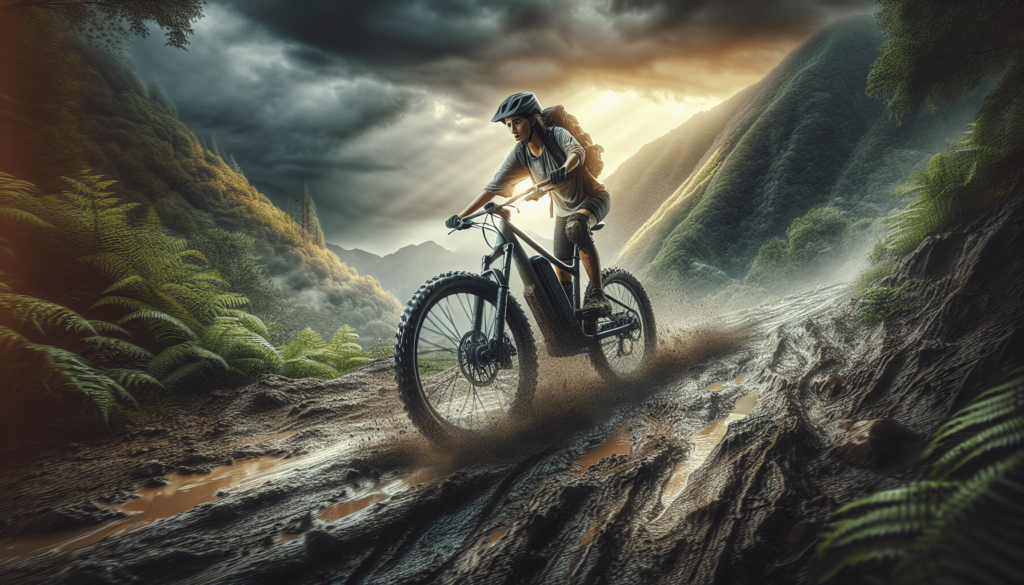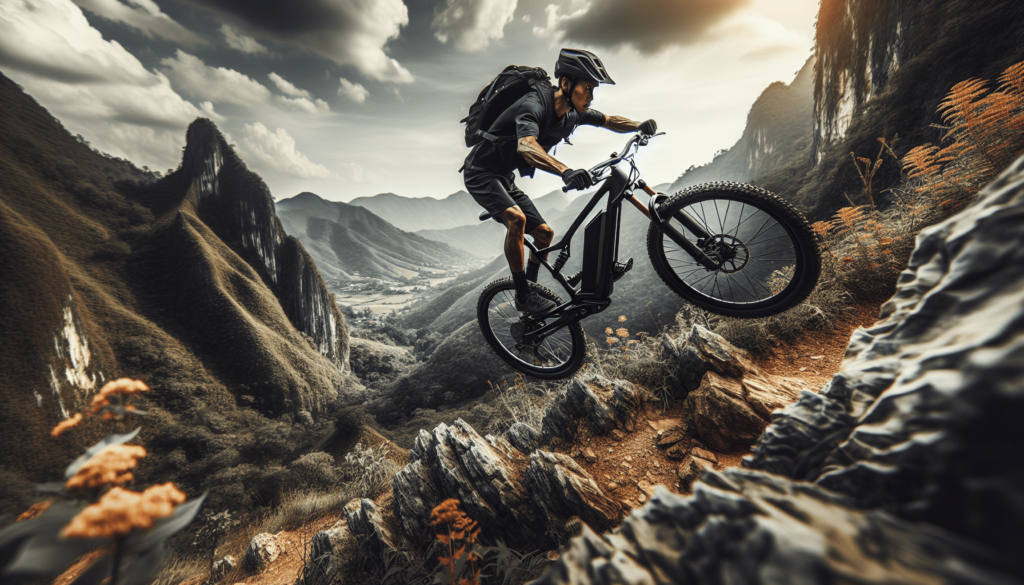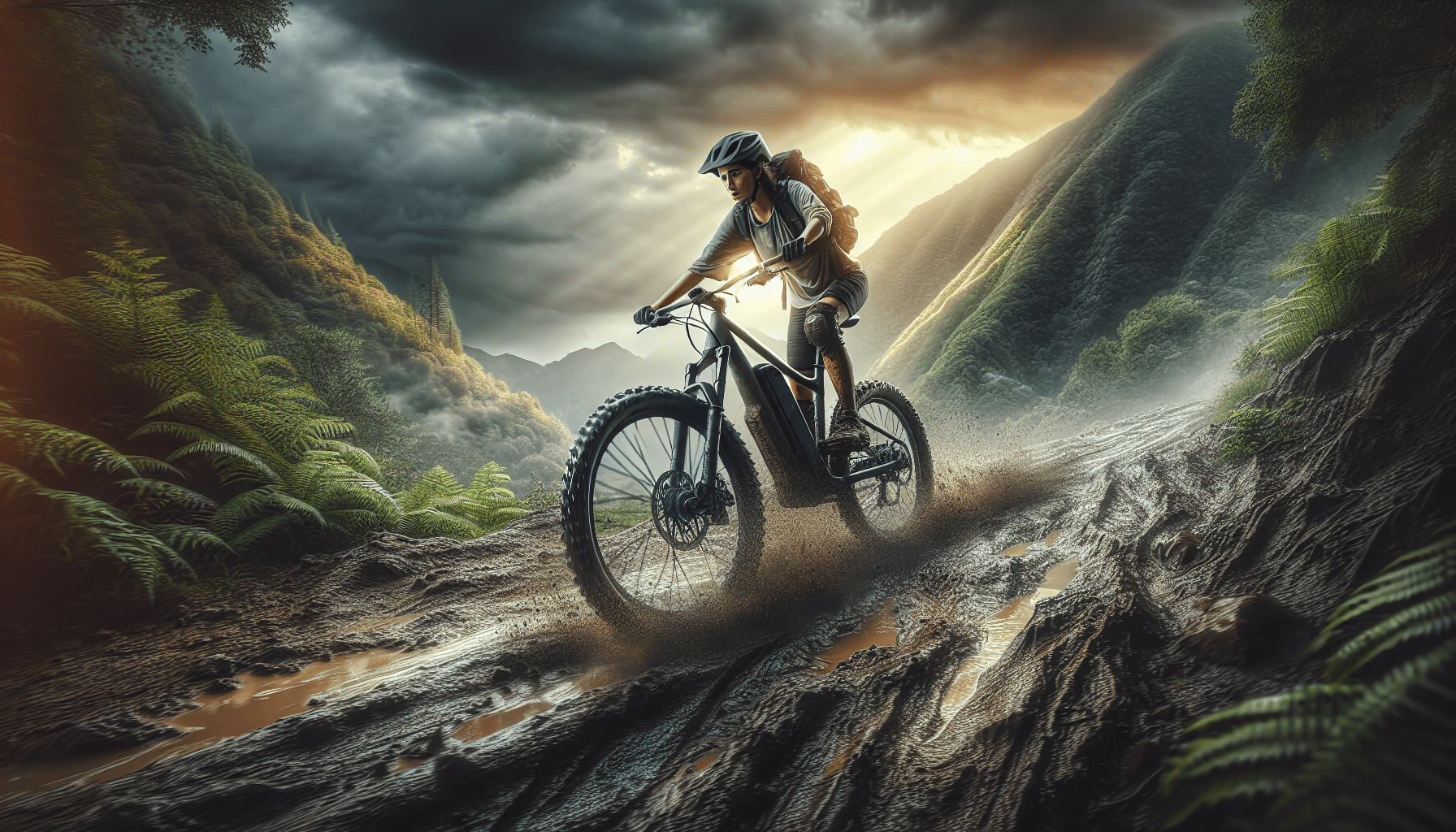You’ve just acquired your brand new e-bike and the thrill of riding it is undeniable. But now comes the burning question: can you take your e-bike off-road and hit those enticing trails? The answer is a resounding yes! e-bikes are not just limited to city streets and bike paths anymore. With their powerful motors and robust frames, they are more than capable of handling the challenges of off-road terrains. So gear up, grab your helmet, and get ready to experience the exhilarating adventure of taking your e-bike off-road on trails.

Understanding E-bikes
What are e-bikes?
E-bikes, short for electric bikes, are bicycles that are equipped with an electric motor, allowing riders to enjoy a boost in speed and power. These bikes provide assistance to the rider while pedaling, making it easier to navigate various terrains and conquer challenging trails. E-bikes come in various models and styles, catering to different preferences and riding styles.
Different types of e-bikes
There are several types of e-bikes available on the market, each designed for specific purposes. Mountain e-bikes, also known as electric mountain bikes or e-MTBs, are built for off-road adventures and can handle rugged terrains with ease. Fat tire e-bikes, on the other hand, feature wide tires that provide excellent traction and stability, making them suitable for sand, snow, and other challenging surfaces. Additionally, there are hybrid e-bikes, folding e-bikes, and city e-bikes, each serving different purposes and catering to different riding preferences.
Benefits of e-bikes
E-bikes offer numerous benefits for off-road enthusiasts. Firstly, they provide an extra boost of power, allowing riders to conquer steep inclines and difficult terrains with less effort. This makes off-road riding more accessible to a wider range of individuals, regardless of fitness levels or physical abilities. Additionally, e-bikes can extend the range of your adventures, as the electric motor assists with pedaling, reducing fatigue and allowing riders to cover more ground. Furthermore, e-bikes are an eco-friendly alternative to traditional modes of transportation, as they emit fewer greenhouse gases and minimize the carbon footprint.
Considering the Terrain
Types of off-road trails
Off-road trails vary in terrain and difficulty, offering riders a diverse range of experiences. Some popular types of off-road trails include:
Singletrack trails: These narrow trails wind through forests, offering a thrilling and immersive riding experience.
Fire roads: Also known as gravel or dirt roads, fire roads are wider trails that are generally more accommodating to beginners. They provide a smoother riding surface and are often found in national parks and wilderness areas.
Downhill trails: As the name suggests, downhill trails are designed for riders who enjoy the thrill of descending steep slopes and navigating challenging obstacles.
Difficulty levels
Off-road trails are typically categorized into difficulty levels to help riders choose routes that match their skill and fitness levels. These levels may vary slightly depending on the trail system, but commonly include:
Beginner: Suitable for novice riders with little to no off-road experience. These trails are generally flat or have gentle inclines and provide a less technical riding experience.
Intermediate: Slightly more challenging, intermediate trails may have steeper climbs, rocky sections, and tighter turns. Riders should have some off-road riding experience and basic bike handling skills.
Advanced: Advanced trails feature steep climbs, technical descents, and challenging obstacles. Riders should have a high level of fitness, off-road riding skills, and the ability to handle difficult terrain.
Safety precautions
When riding off-road, it is essential to prioritize safety. Here are some key safety precautions to keep in mind:
Always wear a properly fitted helmet and any additional protective gear, such as knee pads and elbow guards, to reduce the risk of injury.
Familiarize yourself with the trail before riding it at high speeds. Note any potential hazards, such as loose rocks, tree roots, or sudden drops.
Ride within your limits and at a speed that allows you to maintain control. Avoid taking unnecessary risks that could lead to accidents or injuries.
Stay hydrated and carry a first aid kit with you in case of emergencies.
Legal Regulations and Trail Access
Local regulations
Before taking your e-bike off-road, familiarize yourself with the local regulations and laws regarding e-bike usage. Regulations may vary from place to place, so it is important to understand the specific rules in your area. Some common regulations include speed limits, e-bike classification requirements, and restrictions on certain trails or areas.
Designated e-bike trails
Many regions have designated e-bike trails that are specifically designed and maintained for off-road e-bike riding. These trails often have suitable terrain, signage, and infrastructure to accommodate e-bikes and ensure a safe riding experience. Check with local biking organizations or government agencies to find out about any dedicated e-bike trails in your area.
National park and wilderness areas
When it comes to riding e-bikes in national parks and wilderness areas, the regulations can vary widely. Some parks allow e-bikes on certain trails, while others have restrictions or entirely prohibit their use. It is crucial to research and respect the guidelines set by park authorities to ensure that you can ride your e-bike responsibly and preserve the natural environment.
Choosing the Right E-bike for Off-road Trails
Mountain e-bikes
Mountain e-bikes, or e-MTBs, are specifically designed for off-road riding and excel at conquering challenging terrains. These bikes feature robust frames, durable components, and high-traction tires, allowing riders to tackle steep climbs and technical descents with confidence. When choosing a mountain e-bike, consider factors such as suspension type (hardtail or full suspension), motor power, and battery range to ensure it suits your specific off-road needs.
Fat tire e-bikes
Fat tire e-bikes are well-suited for off-road adventures on diverse surfaces such as sand, snow, and mud. These bikes feature wide tires with low tire pressure, providing excellent traction and stability. The wider tires also absorb vibrations and bumps, enhancing the overall comfort of the ride. If you plan on exploring terrains beyond typical dirt trails, a fat tire e-bike might be the perfect choice.
E-bike suspension systems
Suspension systems play a crucial role in off-road riding, absorbing impacts and providing better control over rough terrain. There are two main types of suspension systems found in e-bikes:
Hardtail suspension: Hardtail e-bikes have front suspension forks but lack rear suspension. They are lightweight and efficient, making them suitable for riders who prioritize climbing and cross-country riding.
Full suspension: Full suspension e-bikes have both front and rear suspension, offering increased comfort and improved handling on rough trails. These bikes are ideal for riders seeking maximum traction and control when tackling demanding off-road terrain.
Consider your riding style, preferences, and the type of trails you plan to ride when choosing an e-bike with the appropriate suspension system.

Enhancements for Off-road Riding
Upgraded tires
Choosing the right tires can significantly enhance your off-road riding experience. Depending on the terrain you’ll be tackling, consider options such as aggressive tread patterns for improved grip and puncture-resistant casings to minimize the risk of flat tires. Additionally, adjusting tire pressure can greatly affect traction and comfort, so experiment with different pressures to find the sweet spot for your preferred riding conditions.
Considerations for battery life
Off-road riding often involves longer distances and more demanding terrain, which can impact your e-bike’s battery life. To maximize your riding time, consider factors such as the battery capacity, terrain difficulty, and your desired level of pedal assist. Ensure you start with a fully charged battery, carry a spare if necessary, and conserve battery power by selectively using pedal assist levels based on the terrain and your energy requirements.
Protective gear
When riding off-road, it’s essential to prioritize safety by wearing suitable protective gear. Along with a helmet, consider investing in knee and elbow pads, gloves, and protective eyewear to minimize the risk of injuries in case of falls or collisions. Riding off-road can be unpredictable, so being well-equipped with the appropriate protective gear will give you peace of mind and enable you to fully enjoy your off-road adventures.
Skills and Techniques
Advanced braking techniques
Off-road riding often requires quick and precise braking to navigate tight turns and steep descents safely. Learn advanced braking techniques such as modulating the brake pressure, utilizing both brakes simultaneously, and adjusting braking force based on the surface conditions. Practicing these techniques in a controlled environment, such as an empty parking lot or a quiet trail, will help you develop the confidence and skills needed for off-road riding.
Handling rough terrain
Riding off-road involves encountering rough and uneven terrain, such as rocks, roots, and drops. To handle these challenges, focus on maintaining a balanced and relaxed position on the bike, shifting your weight as needed to maintain traction and control. Develop your bike handling skills by practicing on progressively more challenging terrains, gradually building your confidence and ability to navigate through technical sections.
Maintaining balance and control
Off-road riding requires excellent balance and control, especially when encountering unexpected obstacles or technical features. Practice maintaining a centered position on the bike, using your core strength to stabilize your body. This will enable you to react quickly and smoothly to changes in terrain while maintaining control of your e-bike. Regular balance exercises, such as track stands and slow-speed maneuvering, can significantly enhance your stability and control on off-road trails.
Preparation and Maintenance
Pre-ride checklist
Before heading out on an off-road ride, it is crucial to perform a pre-ride checklist to ensure your e-bike is in optimal condition. Check the tire pressure, inspect the brakes, gears, and suspension, and ensure that the battery is fully charged. Additionally, carry essential tools, a spare tube, and a pump to handle any unexpected maintenance issues that may arise during your ride.
Regular maintenance routine
Off-road riding can be demanding on your e-bike, so implementing a regular maintenance routine is essential to keep your bike in top shape. Clean your e-bike after each ride, paying attention to the drivetrain, brakes, and suspension components. Regularly inspect and lubricate the chain, replace worn-out brake pads or tires, and ensure all bolts are tightened to the manufacturer’s specifications. If you’re unsure about the maintenance requirements of your e-bike, consult the user manual or seek advice from a professional bike mechanic.
Cleaning and lubricating
Cleaning your e-bike after each off-road ride is vital to remove dirt, mud, and debris that can cause premature wear and damage. Use a mild detergent and a soft brush to gently clean the frame and components, avoiding high-pressure water that may infiltrate sensitive areas. After cleaning, dry your e-bike thoroughly and apply lubricant to the chain, derailleur, and other moving parts. Regular cleaning and lubrication will not only prolong the lifespan of your e-bike but also improve its performance on the trails.
Joining E-bike Off-road Groups
Connecting with local riders
Joining e-bike off-road groups can be an excellent way to connect with like-minded individuals and expand your off-road riding network. Seek out local biking clubs or online communities where you can find fellow riders who share your passion for e-bike off-roading. These groups often organize group rides, share trail recommendations, and provide valuable insights and tips specific to your local area.
Group rides and events
Group rides and events are a great opportunity to not only enhance your off-road skills but also foster a sense of camaraderie within the e-bike off-road community. Participating in group rides allows you to learn from more experienced riders, discover new trails, and gain confidence in navigating challenging terrains. Check local biking events or reach out to e-bike off-road groups to find out about upcoming group rides or organized events in your area.
Sharing experiences and tips
The e-bike off-road community is known for its openness and willingness to share knowledge and experiences. Engage with fellow riders by sharing your own adventures, tips, and recommendations for off-road trails. Likewise, be open to receiving advice and guidance from more experienced riders. Sharing experiences and tips not only helps build connections but also contributes to the growth and development of the e-bike off-road community as a whole.
The Advantages and Disadvantages
Benefits of off-road e-biking
Off-road e-biking offers numerous advantages. The added electric assistance enables riders to explore challenging terrains with ease, regardless of their fitness level or physical ability. E-bikes also extend the range of off-road adventures, allowing riders to cover more ground and explore new landscapes. Moreover, off-road e-biking offers an exhilarating and immersive outdoor experience, connecting riders with nature and providing a sense of freedom and adventure.
Challenges and limitations
While off-road e-biking has many benefits, it also presents specific challenges and limitations. One of the primary challenges is the maintenance and care required for e-bikes, especially when riding in challenging terrains. Rough trails, jumps, and technical features can put additional stress on the bike’s components, requiring more frequent maintenance. Additionally, e-bikes are generally heavier than traditional bikes, which can impact maneuverability and handling in certain situations.
Environmental impact
Off-road e-biking, like any other recreational activity, can have an environmental impact. It is essential to ride responsibly, respect nature, and follow the principles of Leave No Trace. Avoid damaging sensitive habitats, stay on designated trails, and yield to hikers and equestrians. By being mindful of our impact on the environment, we can ensure the preservation and enjoyment of off-road trails for future generations.
Tips for Responsible Off-road Riding
Respecting nature and wildlife
When venturing off-road, it is crucial to respect the natural environment and wildlife. Avoid disturbing animal habitats or vegetation and refrain from littering. Keep noise levels to a minimum to prevent unnecessary stress to wildlife and fellow trail users. By respecting nature, we can create harmonious interactions and preserve the beauty of off-road riding destinations.
Yielding to hikers and horses
Off-road trails are often shared with hikers and equestrians, so it is important to yield the right of way to these users. Slow down, announce your presence, and give them enough space to pass safely. By practicing trail etiquette and showing courtesy to others, we can ensure a positive and respectful experience for everyone.
Leaving no trace
The principle of Leave No Trace emphasizes the importance of minimizing our impact on the environment. Pack out any trash or waste, including food scraps and packaging. Avoid damaging vegetation or disturbing natural features. Leave the trail as you found it, ensuring that you leave no trace of your presence. By adopting these practices, we can preserve the beauty and integrity of off-road trails.
In conclusion, e-bikes have revolutionized off-road riding, providing a thrilling and accessible experience for riders of all skill levels. Understanding the different types of e-bikes, choosing the right bike for off-road trails, and enhancing your skills and techniques are crucial aspects of enjoying off-road e-biking to the fullest. By following legal regulations, respecting the environment, and prioritizing safety, you can embark on unforgettable off-road adventures while minimizing your impact and preserving the natural beauty of the trails. So, gear up, hit the trails, and let the electrifying freedom of off-road e-biking take you on exciting new journeys.

